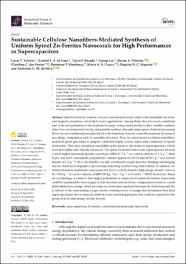Mostrar el registro sencillo del ítem
Síntesis sostenible mediada por nanofibras de celulosa de nanocorales uniformes de ferritas de zinc y espinela para altos rendimientos en supercondensadores
| dc.contributor.author | Teixeira, Lucas T. | |
| dc.contributor.author | de Lima, Scarllet L. S. | |
| dc.contributor.author | Rosado, Taissa F. | |
| dc.contributor.author | Liu, Liying | |
| dc.contributor.author | Vitorino, Hector A. | |
| dc.contributor.author | dos Santos, Clenilton C. | |
| dc.contributor.author | Mendonça, Jhonatam P. | |
| dc.contributor.author | Garcia, Marco A. S. | |
| dc.contributor.author | Siqueira, Rogério N. C. | |
| dc.date.accessioned | 2023-09-22T22:01:22Z | |
| dc.date.available | 2023-09-22T22:01:22Z | |
| dc.date.issued | 2023-05-24 | |
| dc.identifier.uri | https://hdl.handle.net/20.500.13053/9458 | |
| dc.description.abstract | Spinel ferrites are versatile, low-cost, and abundant metal oxides with remarkable electronic and magnetic properties, which find several applications. Among them, they have been considered part of the next generation of electrochemical energy storage materials due to their variable oxidation states, low environmental toxicity, and possible synthesis through simple green chemical processing. However, most traditional procedures lead to the formation of poorly controlled materials (in terms of size, shape, composition, and/or crystalline structure). Thus, we report herein a cellulose nanofibersmediated green procedure to prepare controlled highly porous nanocorals comprised of spinel Zn-ferrites. Then, they presented remarkable applications as electrodes in supercapacitors, which were thoroughly and critically discussed. The spinel Zn-ferrites nanocorals supercapacitor showed a much higher maximum specific capacitance (2031.81 F g−1 at a current density of 1 A g−1 ) than Fe2O3 and ZnO counterparts prepared by a similar approach (189.74 and 24.39 F g−1 at a current density of 1 A g−1 ). Its cyclic stability was also scrutinized via galvanostatic charging/discharging and electrochemical impedance spectroscopy, indicating excellent long-term stability. In addition, we manufactured an asymmetric supercapacitor device, which offered a high energy density value of 18.1 Wh kg−1 at a power density of 2609.2 W kg−1 (at 1 A g−1 in 2.0 mol L−1 KOH electrolyte). Based on our findings, we believe that higher performances observed for spinel Zn-ferrites nanocorals could be explained by their unique crystal structure and electronic configuration based on crystal field stabilization energy, which provides an electrostatic repulsion between the d electrons and the p orbitals of the surrounding oxygen anions, creating a level of energy that determines their final supercapacitance then evidenced, which is a very interesting property that could be explored for the production of clean energy storage devices | es_PE |
| dc.format | application/pdf | es_PE |
| dc.language.iso | spa | es_PE |
| dc.publisher | MDPI | es_PE |
| dc.rights | info:eu-repo/semantics/openAccess | es_PE |
| dc.rights.uri | https://creativecommons.org/licenses/by/4.0/ | es_PE |
| dc.subject | : supercapacitors; Zn-ferrites; controlled nanomaterials; nanocorals | es_PE |
| dc.title | Síntesis sostenible mediada por nanofibras de celulosa de nanocorales uniformes de ferritas de zinc y espinela para altos rendimientos en supercondensadores | es_PE |
| dc.type | info:eu-repo/semantics/article | es_PE |
| dc.identifier.doi | https://doi.org/10.3390/ijms24119169 | |
| dc.type.version | info:eu-repo/semantics/publishedVersion | es_PE |
| dc.publisher.country | CRI | es_PE |
| dc.subject.ocde | 3.03.00 -- Ciencias de la salud | es_PE |
Ficheros en el ítem
Este ítem aparece en la(s) siguiente(s) colección(es)
-
Web of Science (WOS) [236]


